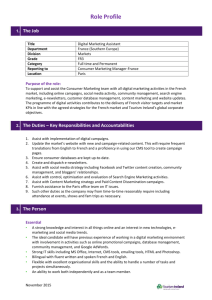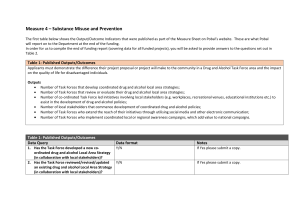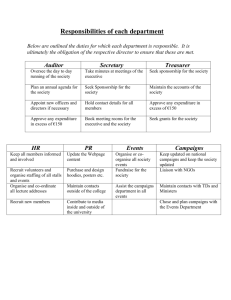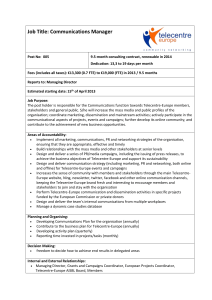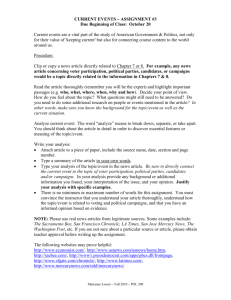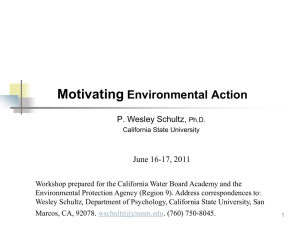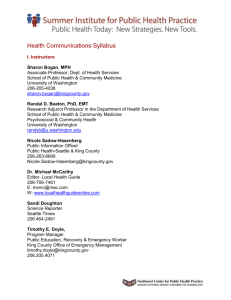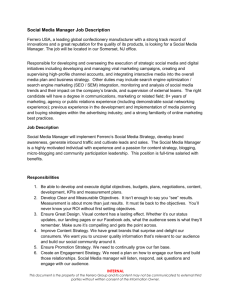The Role of Clients in the Public Relations Campaigns Course
advertisement
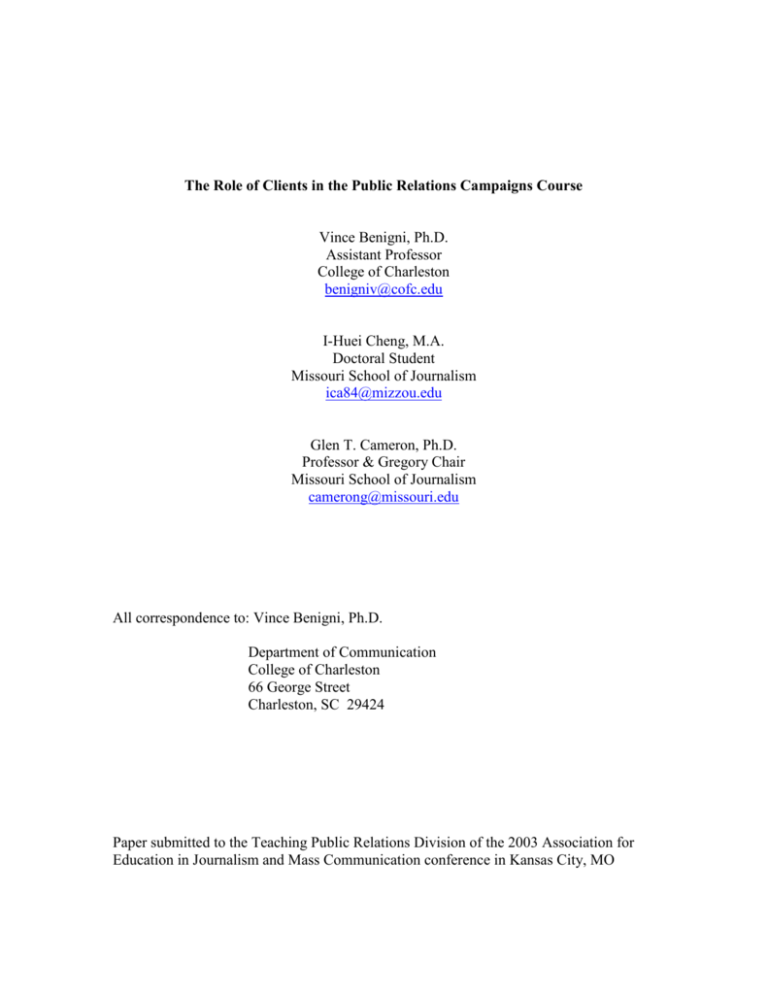
The Role of Clients in the Public Relations Campaigns Course Vince Benigni, Ph.D. Assistant Professor College of Charleston benigniv@cofc.edu I-Huei Cheng, M.A. Doctoral Student Missouri School of Journalism ica84@mizzou.edu Glen T. Cameron, Ph.D. Professor & Gregory Chair Missouri School of Journalism camerong@missouri.edu All correspondence to: Vince Benigni, Ph.D. Department of Communication College of Charleston 66 George Street Charleston, SC 29424 Paper submitted to the Teaching Public Relations Division of the 2003 Association for Education in Journalism and Mass Communication conference in Kansas City, MO Teaching Public Relations Campaigns Course –1 Abstract Extending Benigni and Cameron (1999), this study provides a current review of teaching methods for the public relations campaigns course based on a national survey. In addition to offering up-to-date descriptions of how the campaigns course is constructed and valued in public relations programs, this study analyzed what may be important factors that influence the course outcomes. Clients’ satisfaction, implementation of plan books that are developed by students, and job/internship opportunities that students receive based on their performance in the campaign course are all indicators for the effectiveness of teaching campaign courses. Certain course features, client involvement in class, and clients’ payment for services rendered also contribute to more positive course outcomes. Teaching Public Relations Campaigns Course –2 Introduction Within a public relations major or sequence, students are generally required to understand the principles of the profession, and then take subsequent courses in research, writing, management, and finally, the campaigns course (Undergraduate Commission citation). Because it is generally considered the capstone course (Benigni and Cameron 1999) of public relations education, the campaigns class has a multi-faceted obligation to its students. In one semester, students are often asked to conduct focus groups, formulate questionnaires and analyze data to fulfill a primary research requirement. Setting measurable objectives, and devising strategies and tactics are planning prerequisites (Wilcox, Cameron, Ault and Agee 2003) bridging research to the communication phase (e.g. press kits, web site copy and broadcast tactics). Finally, an effective evaluation proposal may include assessment strategies ranging from advertising equivalency and other motivational objectives to benchmarking and more evolved informational outcomes. Students (and sometimes professors) may find the process overwhelming, but necessary, because of the pivotal assessment of outcomes. In other words, the portfolio and final presentation are not only intrinsic rewards for the exhaustive rite of passage/survival skills (Bourland-Davis 2002), but more importantly, are tangible recruiting tools for internship and/or career opportunities. Not only do participants benefit, but the department and university also gain positive exposure and enrichment from holistic learning experiences. However, many would argue that the primary beneficiaries of the campaigns course are the clients (Aldoory and Wrigley 2000). In most cases, campaign students work in teams on behalf of a campus or community organization, presenting their Teaching Public Relations Campaigns Course –3 findings and portfolios to the client at semester's end. In many respects, the clients are the essence of the major's most important course. While replicating most elements of Benigni and Cameron’s national survey in 1999, this study adds greater focus on the client's role in the campaigns course, based on the perceptions and experience of the professors, particularly with regard to client expectations, involvement, and trust. Literature Review Teaching the Campaigns Course Public relations pedagogy has been a rich source of scholarship in recent years, both in a holistic sense, and through analysis of specific courses. Most scholars agree that all public relations courses should incorporate “real-world” scenarios, even though it often adds to professor workload. Over the past decade, a number of articles have dissected individual components of the suggested elements of the public relations major by the Undergraduate Commission on Public Relations Education. These include works on the introduction/principles course (Benigni, Weaver-Lariscy and Tinkham 2002), the writing course (King 2001), case studies (Rybacki and Worley 2000) and management (Kinnick and Cameron 1994). In fact, case studies (Hendrix 2001) and management (Schick 1997) are considered by some researchers as capstone tenets. That being said, most scholars have agreed that the campaigns class involves the most complete application of essential skills in public relations. Some universities even use a two-semester approach (Metzler and Nadler 2000) because of the rigor involved in synthesizing skills learned in prerequisite courses. Because of the didactic nature of prerequisites, upper-level offerings should Teaching Public Relations Campaigns Course –4 foster “active learning” or collaborative strategies (Lubbers and Gorcyca 1997) that represent real-world opportunities. Many universities espouse hybrid programs that fuse concepts of business and public relations (Pincus and Rayfield 1992). While integrated communication (Reber, Frisby, and Cameron, in press) has gained significant momentum, other scholars believe that public relations is a distinct profession, and not a subset of related professional areas or disciplines (Kruckeberg 1998). Traditionally, the purveyors of student excellence are their professors, who write recommendation letters, make phone calls to companies or graduate schools, and serve as mentors and confidants. Indeed, teachers set a tone for future success, both with theoretical grounding and practical application. The latter tonic is often more palatable to students, because their motivational objectives usually revolve around their success after college. Research suggests that those students with considerable "real-world" application are more competitive in today's job market. Outcomes are not just measured by news release competency, but also in attitude (Neff et al. 1999). Most campaigns courses are taught within a team-based framework (Benigni and Cameron 1999). Oftentimes, objectives are compromised when one or more students do not pull their weight (Lordan 1996). These difficulties can be assuaged by more proactive strategies, such as incorporating teams in the intro course (Adams 1994). Teaching Campaign-Based Skills Research, viewed as the critical impetus for decision-making (Broom & Dozier 1990), is given lip service by many public relations professors (DeSanto 1996). Stacks (2002) argued that the introduction to public relations course must allay students’ fears of numbers to provide a positive stimulus for the subsequent research methods offering. He Teaching Public Relations Campaigns Course –5 offers “Four Myths” (Research as Math, Memorization, Non-Career Oriented, and Hindrance in Competing with Business Students) that professors must address through theoretical and application exercises. One of the key elements of a campaign’s planning phase is the setting of strategic objectives. Fall (1998) noted that event management was listed as a critical need area in student internships and organizational campaigns, with motivational objectives (Wilcox et al. 2003) being a particularly illuminating evaluative tool. Informational, awarenessbased objectives (Beasley 1992) are more difficult to ascertain, hence the reason that many campaigns professors require survey instruments to gauge public sentiment. While highly evolved research techniques are stressed, Coombs and Rybacki (1999) lament the limited use of new media pedagogy in public relations classes. Brody (2002) notes that traditional media relations tactics (i.e. news releases) are outmoded, and need to manage transitions into a new age of “experience-based messaging systems.” Still, a number of professors are embracing new technologies within the pedagogical construct. Kent (2001) espouses a mediated approach emphasizing web-based education of secondary research of media outlets and key databases. Forde (2000) suggests a requisite integration of desktop publishing skills (i.e. PowerPoint and Netscape Composer) in the campaigns course for competitive portfolio building, because portfolios are the critical tool of student assessment (Flynn and Russell 2000). Many capstone courses address the issue of evaluation, but time constraints do not allow for campaign implementation (Benigni and Cameron 1999). However, public relations education task forces are emphasizing equal weights for implementation as well as planning, because outcome perspectives (Gibson 1992) are not being properly Teaching Public Relations Campaigns Course –6 addressed in capstone education. Benchmarking (Richter and Drake 1993) should assess the impact of financial rewards of organizations. Rybacki and Lattimore (1999) argue that many professors eschew opportunities to assess student outcomes at their institution, and therefore, are ill-equipped to broach evaluative issues in public relations classes. Forde (2000) notes that focus groups can offer insights of current students and graduates toward academic departments. In sum, outcome perspectives and university perception are key variables that can be strategically ascertained. Service Learning Relationship building has long been a primary tenet of excellent (Grunig, 1992) public relations. Bruning and Ledingham (1999) operationalized three types of relationships – personal, professional, and community – that significantly influenced key public member evaluations of satisfaction with the organization. University professors are increasingly espousing the notion of service learning as a “counter to ivory tower intellectualism” (Schwartzman 2001), a networking tool for graduates (Tucker and McCarthy 2001), a practice to alleviate tensions inherent in nonreciprocal relationships (Dubinsky 2002), and an extension of traditional university missions (Fall 2002). In public relations courses, managing university-student relationships is a critical variable in gauging student retention (Bruning and Ledingham 1999), and in ascertaining alumni attachments and subsequent donation behaviors (Sallot 1996). Service learning provides a forum to build professionalism (Bourland-Davis 2000), but only if the emphasis of learning is equal or greater to the notion of service (Patterson 2002). Teaching Public Relations Campaigns Course –7 The Role of the Client While many capstone courses use case studies to illustrate do's and don'ts of public relations campaigns, students are not properly prepared unless they are thrust into a situation filled with problems and opportunities. Fortunately, there is a captive audience within shouting distance of every college campus, ranging from local or regional corporations, to area nonprofits (McPherson 1993), to college offices/organizations. The daunting task for campaigns professors is to choose a set of willing clients. Worley (2001) notes that the most consistently difficult aspect of the campaigns course is to get students to understand, develop, and maintain the team-client relationship. She proposes a “Letter of Agreement” that outlines student needs from the client, along with ways to fulfill client expectations. Filson (1998) adds that a challenge for practitioners is to make the transition for clients into a “leadership” role that extends beyond presentations. Oftentimes, “intellectual readiness” (Maglio-Jung 1994) is required to overcome difficult or even hostile clients, a difficult trait for inexperienced college students to develop quickly. Students should learn client-centered approaches (Motschall and Najor 2001) in the intro course to better prepare for complex organizational issues. Rentner (2000) adds that variables of access and logistics lead campaigns professors to offer only on-campus clients. Conventional wisdom notes that presentations to clients often cement, or doom, the decision to partner with an agency. Miga (1994) suggests a proactive approach where key constituents are briefed at least a week before the presentation. Teaching Public Relations Campaigns Course –8 While the terminal nature of the campaigns course rarely includes the notion of retention, the course should incorporate notions of searching for and retaining clients. Whitney (1997) notes that most sales come from existing customers, and recommendations from those customers. Weems (2001) reports that nearly two-thirds of clients prefer Web-based financial information and advisor-specific sites. Practitioners should emphasize the notion of “clients as long-term investments” over the oft-static nature of current customers/publics. Engaging the client is critical, and trust and satisfaction only come with client involvement in the process (Marken 1997), and keeping clients better informed (Miles 1997). Research Questions Based on the literature, the following research questions were formulated to gauge the role of the client in the public relations campaigns course: RQ1: How are campaigns courses structured? RQ1.1: How are courses offered and structured overall (e.g. being offered to undergraduate or graduate students, use of real clients, and types of clients)? RQ1.2: Does the structure of campaign course differ by type of schools or programs? RQ2: How are clients involved in the campaigns course? RQ2.1: What is the level of research required for clients (e.g. secondary and primary research)? RQ2.2: What is the level of client input in terms of access and grading? RQ3: What are the outcomes of the campaigns courses? RQ3.1: Are clients satisfied with the work provided? Teaching Public Relations Campaigns Course –9 RQ3.2: Are students offered with internship/job opportunities based on campaign efforts? RQ4: How do the outcomes of campaigns course differ? RQ4.1: Do the outcomes differ by course features? RQ4.2: Do the outcomes differ by types of client or other client-related factors? RQ5: How do clients pay for services rendered in the campaigns course? RQ5.1: Is there any formal client payment for services rendered? RQ5.2: Do the outcomes of the campaigns course differ by whether clients pay? Method Sample Based on tenets from Benigni and Cameron’s 1999 study of public relations campaigns professors, and Wrigley and Aldoory’s 2000 manuscript on student and client reactions to the course, we formulated a 60–question survey. Respondents were targeted through a combination of three directories of educational institutions in public relations. Using the 2002-2003 Association for Education in Journalism & Mass Communication Directory of Colleges and Universities, along with the 2002-2003 National Communication Directory of Colleges and Universities, the authors mailed the survey to every institution listed which included public relations as a major, sequence, or course of study. We obtained additional respondents from the “2002 Where Shall I Go to Study Advertising and Public Relations Handbook”. Our directories indicated that 387 universities fulfilled the aforementioned criteria, which was, interestingly, 107 more than the respondent pool from Benigni and Cameron’s survey sent to a similar audience. Variables This study surveys current structure and design of the public relations campaigns course in general, and focuses on the client's role in the campaigns course, as well as the Teaching Public Relations Campaigns Course –10 course outcomes that may be used to assess the effectiveness of teaching campaign courses. Course structures are explored with questions pertaining to the number of class sections, student enrollment numbers, whether the courses are offered to undergraduate and graduate students, whether prerequisites are required for the campaigns course, whether the campaigns courses are required for the public relations program, and whether campaign courses are a “capstone” class in the program. Other course features concern the level of research required in the class, use of class time, involvement of a real client, whether clients are invited to the class to offer an overview, whether students are teamed, how students are grouped, whether students are encouraged to ask more confidential information from clients, and whether clients are formally involved in the grading process. For example, to describe the emphasis of research, these questions were asked, “What percentage of the course is devoted to primary research (in general) and to primary research of the client itself (e.g. client interviews, etc.)?” and “What percentage of the course is devoted to secondary research (in general) and to secondary research of the client?” Concerning the use of class time, these questions were asked, “What percentage of overall class time is devoted to prepared lectures, coach/team meetings, other teaching strategies?” Institution and programs were described by their institutional enrollment size, what degrees are being offered in public relations, and whether the programs are accredited by professional or educational public relations organizations such as Association for Education in Journalism and Mass Communication (AEJMC) and the Public Relations Society of America (PRSA). Teaching Public Relations Campaigns Course –11 Clients’ roles are explored in the aspects regarding their organization type, their willingness to provide information, the interval to offer inputs to the professor, and whether they pay for services rendered in the campaigns course. Regarding the type of clients, respondents were asked with these questions, “Is your client based typically: campus organizations or off-campus organizations?” and “If clients are "off campus," what percentage of your total client base is: government/non-profit, corporate/for-profit, agency, or other?” In addition, respondents were asked to break down percentages of type of clients in response to these questions, “Please break down the approximate percentage(s) of "types of clients" for the following: on-campus v. off-campus, and nonprofit v. for-profit?” Clients’ willingness to provide information to students was measured on a 5-point Likert scale (where 1 is “not willing at all” and 5 is “very willing”) in response to the question, “How willing are clients - to your knowledge - to provide information regarding the organization?” Professors’ relationship with and selection of clients are further explored with these questions, “Do you usually have a prior affiliation or relationship with the client before the organization is chosen?” “Do you seek/accept "referrals" for potential clients from other sources?” and “How much research do you typically do before choosing campaign clients?” measured on a 5-point Likert scale (where 1 is “none/very little research” and 5 is “very much research”). In addition, respondents were asked to report their professional experiences in response to this question, “Please list your background in the following areas in terms of years worked: non-profit PR, corporate/organizational (in-house) PR, agency PR, government PR, and other.” Course outcomes are the satisfaction of the clients, implementation of plan book by the clients, and job or internship opportunity received by students, based on the Teaching Public Relations Campaigns Course –12 perceptions and experience of the professors. The satisfaction of clients were measured on a 5-point Likert scale (where 1 is not satisfied at all, and 5 is very satisfied) in response to the question “How satisfied are clients with the final plan book/portfolio from student groups?” and “How satisfied are clients with the final presentation from student groups?” The implementation of the plan book developed by students was asked with the question, “In your estimation, are student plans used ‘significantly’ by clients?” And to assess the job or internship opportunities students received, this question was asked, “Have any of your students ever received a job/internship opportunity based on the performance of the campaigns course?” Results There were a total of 101 questionnaires completed and returned. The response rate was 26.3 percent, with a number of 384 questionnaires successfully delivered. A total of 387 questionnaires were mailed to the institutions that teach public relations, and three questionnaires returned with an “undeliverable address.” Structures of Course (RQ1) RQ1.1: How are courses offered and structured overall (e.g. being offered to undergraduate or graduate students, use of real clients, and types of clients)? A general description of the sample denoted the following: the average enrollment of responding schools was about 12,400. About 80 percent of responding schools offered a stand-alone campaigns course. About 73 percent of schools offered campaigns classes to undergraduates only, about eight percent to graduate students only, and about 20 percent to both undergraduate and graduate students. Similarly, about three-quarters of respondents indicated they offered a public relations undergraduate major, 28 percent a master’s degree, and six percent a Ph.D. program. More than three- Teaching Public Relations Campaigns Course –13 quarters of respondents considered public relations as at least a sequence, concentration, or major within a specific department. Among the 101 returned questionnaires, there were 30 programs accredited by AEJMC, and 17 by PRSA. The average school had about two full-time faculty members in public relations. Prerequisite classes are required by almost all the schools (except one) for their campaigns course, which is generally a requirement course (about 89 percent) and often considered as a “capstone” course (81 percent) for the public relations major/sequence. Since most respondents indicated that the campaigns course represents a capstone experience, it is not surprising that about 96 percent of the campaigns teachers use actual clients in the class. About 59 percent of professors have a prior affiliation with the client before the organization is chosen, and 92 percent seek or accept “referrals” for potential clients from other sources. Professors generally engage in “moderate” research of potential clients (M= 3.25). Because of the relative difficulty in finding new clients, 29 percent of professors use the same client in more than one semester. This practice may also be reflected in the large enrollment per class (average of 22 students, and mode of 19 students) and teambased nature of agency work, which requires a good deal of client contact by the professor, especially for new clients. About 92 percent of campaigns are handled by student groups, with an average of five students per group. Interestingly, about 44 percent of groups compete against other groups in the class for the same client. Student teams are primarily formed by professors based on student interest and input (about 47 percent), followed by the students themselves (about 33 percent) and “random choices” by professor (about 15 percent). About 90 percent of courses work Teaching Public Relations Campaigns Course –14 with an “agency” structure, with 49 percent having weekly meetings, and 26 percent having fewer meetings than once per week. Nearly 58 percent of respondents invite clients to “offer an overview” about their organization before the teams are chosen. Campaigns clients are typically off-campus as opposed to on-campus organizations (average of 67 percent v. 30 percent), and mostly nonprofit as opposed to for-profit organizations (average of 77 percent versus 23 percent). RQ1.2: Does the structure of campaign course differ by type of schools/programs? Regardless of the size of the institutions and whether the programs are accredited by AEJMC or PRSA, the average class enrollment is about the same, with larger schools offering more sections of classes. Regarding the degrees offered, accredited programs are, not surprisingly, more likely to offer graduate degrees in public relations than unaccredited programs (41% v. 20%, one-sided Fisher’s Exact Test: p < .05). Similarly, these accredited programs then offered their campaigns course at graduate level only or both more often than the unaccredited do (47.2% v. 12.8%, one-sided Fisher’s Exact Test: p < .001). The programs accredited by AEJMC or PRSA are found more likely to offer public relations campaigns course than the unaccredited programs (91% v. 70%, onesided Fisher’s Exact Test: p < .05). Accredited programs, as opposed to the nonaccredited ones, more often require the campaigns course for the public relations major (97% v. 85%, one-sided Fisher’s Exact Test: p= n.s.) and have the course as a capstone class (87% v. 74%, one-sided Fisher’s Exact Test: p=n.s.), but such differences were not statistically significant. And there was not much other difference either in requiring prerequisites, using real-world clients, or generally having mainly off-campus, non-profit clients. Teaching Public Relations Campaigns Course –15 Levels of Client Research and Client Involvement (RQ2) RQ2.1: What is the level of research required for clients (e.g. secondary and primary research)? Since prerequisite courses should broach elements of secondary research, it stands to reason that all respondents expect students to employ web-based research of the client and the client’s industry. In fact, only 18 percent of all lecture sessions are devoted to secondary research, nearly all of that regarding the client itself (please note that only 35 percent of the entire course structure is devoted to lectures, the same percentage earmarked to team/student meetings). In general, clients are willing (M= 3.80) to provide information regarding their organization. Students are slightly more willing (M= 4.03) to ask clients for information regarding their organization. Nearly 60 percent of professors do not ask students to seek “confidential” information from clients. If they do, students are generally asked to request clients’ internal information regarding budgets (91 percent), organizational plans (91 percent), organizational hierarchy/charts (88 percent), or timetables/Gantt charts (75 percent). Regarding the areas where students conduct secondary research, nearly 94 percent of professors require a review of organizational brochures, 91 percent require a review of media accounts regarding the organization, 90 percent require a perusal of newsletters, and 81 percent expect students to review web sites of an organization’s competitors. Primary research takes up almost one-fifth of all lecture time. This research includes the forms of focus groups, in-depth interviews and/or a survey instrument. In fact, survey data ranks favorably among other campaign components. Teaching Public Relations Campaigns Course –16 Three-quarters of respondents utilize conversation and meetings with clients during the term, and about 73 percent indicate a formal meeting with clients at the end of the term as well. More than 57 percent of respondents incorporate a formal group evaluation and/or a client questionnaire at the end of the term. RQ2.2: What is the level of client input in terms of access and grading? Client input generally does not foray into grading, as two-thirds of respondents noted that clients aren’t a formal part of the process. Even those who enlist clients in the grading process do not provide for significant impact, with client input accounting for just 18 percent of the final grade. The client suggests a final grade for the student/team in nine percent of all cases, even though final presentations are given for 89 percent of all campaigns, and portfolios are also a significant assessment requirement. As for the frequency that clients provide input, 38 percent of professors reported that they seek clients’ input “about two or three times” during the term, while 22 percent said they do so “at the end of the term only.” About 18 percent of professors are quite proactive, consulting with clients “weekly or regularly.” Client Satisfaction and Other Outcomes of Course (RQ3) RQ3.1: Are clients satisfied with the work provided? While client assessment generally doesn’t involve grading, it is highly valued by professors and students. Generally, assessment is highly positive. Final presentations from student groups were considered outstanding (M= 4.37). The final plan book/portfolio also merited great praise (M= 4.26). RQ3.2: Do clients offer students internship/job opportunities based on campaign efforts? Client satisfaction often carries over beyond the presentation, as 89 percent of campaigns students have received a job or internship opportunity based on their Teaching Public Relations Campaigns Course –17 performance in the course. In some cases, clients have received positive exposure because of the campaign. About 16 percent of student groups have received media coverage from the final presentation, primarily from local print media. Satisfaction also extends beyond the scope of the presentation. Nearly 70 percent of clients, in professors’ estimations, use the student plans “significantly.” Special event tactics were perceived as the most utilized campaign components, followed by collateral/communication materials (e.g. releases, press kits), and data from surveys/focus groups. Other components that ranked well behind the others included: research appendices (e.g. mailing/phone lists, media contacts), revised mission/objectives, research strategies, evaluation techniques, timetable/Gantt charts, social responsibility strategies, and budgetary suggestions. Important Course Features and Client-related Factors (RQ4) RQ4.1: Do the outcomes differ by course features? Certain course features are found to have influence on clients’ satisfaction regarding final presentation and plan book, their implementation of the plan book, as well as provision of job/internship opportunities. Professors who designed the course to include the client in the formal grading process, are more likely to report that plan books are used (91% v. 61%, one-sided Fisher’s Exact Test: p < .05), and more likely that their students have been offered a job/internship opportunity (100% v. 82%, one-sided Fisher’s Exact Test: p < .05). In addition, campaign courses that involve graduate students (courses offered to graduate students only or to both undergraduates and graduates) are more likely to be reported with actual use of the plan book, as opposed to courses offered only to undergraduate students (95% v. 58%, one-sided Fisher’s Exact Test: p < .05). Teaching Public Relations Campaigns Course –18 Student competition seems to lead to higher satisfaction with the plan book, but the difference was not significant (M= 4.35 v. 4.17, F (1, 67) = 1.47, p = n.s.). Similarly, it was found that students competing in courses may result in more implementation of the plan book, but with a non-significant difference as well (35% v. 28%, one-sided Fisher’s Exact Test: p = n.s.). Courses where the plan books were used by the clients usually involved more research elements, especially more primary research of the client (in terms of class percentage). Although the difference was not statistically significant (M= 16% v. 11%, F (1, 62) = 3.2, p = n.s.), a notable difference was found with plan book use being half again higher in use of primary research. Other research elements (i.e. primary research in general, secondary research in general, and secondary research of client) were found with also positive but less influence in contributing to the use of the plan book. RQ4.2: Do the outcomes differ by types of client or other client-related factors? Few other client-related factors were found potentially influencing client satisfaction about the plan book and presentation, use of plan book, and internship opportunity. It was only found that if clients were invited to class to offer an overview about their organization, the plan books developed by students were more likely to be used than the cases where there were no clients’ overview in class (84% v. 46%, onesided Fisher’s Exact Test: p < .05). The level of client satisfaction with plan books was found positively correlated with the level of clients’ willingness to provide information, but the result was not significant (r= .22, p = n.s.). However, whether clients pay for services rendered in the campaign course may relate to their use of plan book and provision of internship opportunity, which will be addressed below. Pro Bono Assistance: Opportunity Lost? (RQ5) RQ5.1: Is there any formal client payment for services rendered? Teaching Public Relations Campaigns Course –19 Benigni and Cameron (1999) note that a “formal payment” by clients (for services rendered) should be strongly considered by campaigns professors. Only about onequarter of respondents ask for payment. Of those clients that pay, about 62 percent reimburse students only for materials used to formulate the plan and presentation, 19 percent offer a stipend to be used by the academic department/class for academic purposes, and about 10 percent pay for research software implemented in the class. RQ5.2: Do the outcomes of campaign course differ by whether clients pay? Respondents who reported that their clients paid also thought that their clients are more satisfied with the work, although the result was not statistically significant. But in courses where their client have paid for services rendered, plan books developed by students are more likely to be used (90% v. 79.6%, one-sided Fisher’s Exact Test: p < .05) and students were more likely to receive internship opportunity based on the class performance (100% v. 83.6%, one-sided Fisher’s Exact Test: p < .05). These findings are probably a reflection of the finding that 75 percent of respondents use nonprofit clients, and only 24 percent enlist corporate/for-profit businesses. However, professors are generally trained in both corporate (average of 3.75 years of experience in agency public relations and/or corporate and organizational public relations) and nonprofit/government (average of 3.6 years of combined experience). Discussion Our research questions were addressed to depict current structures of campaigns courses in public relations programs, clients’ involvement in the course and the outcomes that indicate the effectiveness of course elements, as well as to explore course features that may influence the outcomes. We found that although campaigns courses are structured in a variety of ways, some clear patterns emerge. Most public relations Teaching Public Relations Campaigns Course –20 programs offer campaigns courses (about 79 percent), primarily to undergraduate students (about 73 %), and generally students are required to take this course. The campaigns courses, almost all requiring prerequisite classes, are also often considered as a capstone course in the program (81%). Most campaigns courses use actual clients, typically off-campus, non-profit organizations. Clients’ involvement in class have been found important in many ways, such as paying for services rendered, introducing their organizations in class, providing information to students, and being involved in the grading process. Professors should encourage payment from clients, at least for materials used for creating plan books. Moderate stipends to academic departments are a reasonable expectation in an agency setting where real-world firms would charge tens of thousands for a typical campaign. Clients should be invited to the class to make a “pitch”, offering an organizational overview and addressing their situation to the class, early in the semester, before the teams are chosen. Alternatively, students could visit the respective venues. Our findings showed that professors who invited clients to their classroom often found the students’ plan books significantly used by the clients. Clients’ overview of their organizations in class, as opposed to institutional brochures and web sites, are informative, personal and evocative backdrops that also motivate students to engage in client services work. The willingness of clients to provide information is found positively related to their later satisfaction with the presentation of students’ work and the developed plan books. Professors need to engage clients in the need for full disclosure because students may not be able to delve into problems or opportunities unless they are privy to budgets, timetables, and organizational mission and objectives. Clients need to be more accessible Teaching Public Relations Campaigns Course –21 with regard to “confidential” information, and students need to “demand” that information more, through professor guidance. Our data showed that if clients were involved in the formal grading process, students’ plan books were also more likely to be used by the clients. This may be because clients in this case are more engaged in providing feedback to professor and potentially to students also. We value the clients’ feedbacks as inputs but do not suggest their direct role in grading. We applaud professors’ autonomy in their carefully involving clients in the grading process. While our survey showed that clients have a “formal say” in the grading process (33 percent), client input is mainly a supplemental tool (accounting for only 18 percent of final grade, and only 9 percent of those courses including client in formal grading process would have clients suggest a final grade). While plan book and presentation are critical outcomes to the course, a third “p” (publicity), is generally eschewed. Professors should encourage students to pursue local and regional media during the campaign process. Media and other outlets should be used as a proactive tactic (invited to presentations, etc.), not just post hoc to the campaign itself. Professors should also stress to students and clients, the importance of virtually ignored campaign components such as evaluation techniques (i.e. benchmarking), social responsibility strategies, budgetary suggestions, timetables, and evaluation of mission and objectives. Sometimes, the course gets bogged down into a replication of short-term technical tasks, rather than as an evolved management function. Research components, especially primary research of the clients, were found positively related to higher clients’ satisfaction and more use of plan books. The average percentages of class devoted to secondary and primary research, in general and of the client, all range around 15 to 19 percent. Because of the important contribution of Teaching Public Relations Campaigns Course –22 research to the quality of plan books, and its value in training students’ intellectual abilities in the profession, prerequisite courses should cover research methods and how to interpret research findings, and campaigns course teachers should guide students to apply the research results to the development of communication strategy. Limitations We recognize that our findings can be better generalized with a larger final sample size or higher response rate, even though our response rate would be considered good for a mail survey. We suspect that the non-responses included large numbers of individuals at programs that do not provide public relations campaigns courses. Ignoring this confound between non-response and ineligibility for inclusion in the study, findings of our survey still provide a useful description of the designs and important features of today’s campaigns courses, which are crucial in teaching students to become professionals in our field. Our respondents were campaigns course instructors in the educational institutions where degrees or concentrations in public relations were offered. Many of our measurements concerning course outcomes or effectiveness of elements of campaigns courses were based on the instructor’s subjective perception, experience, and projection. Answers provided by our respondents were also based on their overall, aggregate impression, not specifically for one client or a particular campaigns class. We believe that future research focusing on students’ and clients’ perspectives with a triangulation approach can provide more in-depth description of the interaction among the professors, clients, and students, and a better understanding of why certain course features and client-related factors become important for course outcomes. Teaching Public Relations Campaigns Course –23 References Adams, W.C. (1994). Using Case Studies in the Introductory Public Relations Course, Public Relations Division/AEJMC, 34 (Todd Hunt, editor). Aldoory, L. & Wrigley, B. (2000). Exploring the Use of Real Clients in PR Campaigns Courses. Journalism & Mass Communication Educator, 54 (4), 47-58. Beasley, W. (1992). Towards Student Autonomy: A Standards-Based Approach. The Science Teacher, 59 (6), 46-49. Benigni, V.L., Weaver-Lariscy, R.A., & Tinkham, S.F. (2002). To Evolve is to Involve: Analyzing Student Choice in the Introduction to Public Relations Class. Journalism & Mass Communication Educator, 56 (4), 6-18. Benigni, V.L. & Cameron, G.T. (1999). Teaching Public Relations Campaigns: The Current State of the Art. Journalism & Mass Communication Educator, 54 (2), 5160. Bourland-Davis, P.G. (2002). A Cultural Perspective of the Course Students Love to Hate: The Capstone Course. Paper Presented to Public Relations Division of National Communication Association Annual Conference, New Orleans, LA. Bourland-Davis. P.G. (2000). Does Service Learning Extend to and Beyond the Public Relations Internship? Paper Presented to Public Relations Division of National Communication Association Annual Conference, Seattle, WA. Brody, E.W. (2002). Clients and Employers. Public Relations Quarterly, 47 (2), 7-9. Broom, G.M. and Dozier, D.M. (1990). Using Research In Public Relations. Englewood Cliffs, NJ, Prentice-Hall. Bruning, S.D. & Ledingham, J.A. (1999). Relationships Between Organizations and Publics: Development of a Multi-Dimensional Organization-Public Relationship Scale. Public Relations Review, 25, 157-170. Coombs, W.T. & Rybacki, K.C. (1999). Public Relations Education: Where is Pedagogy? Public Relations Review, 25 (1), 55-63. DeSanto, B.J. (1996). The State of Research Education in the Public Relations Curriculum. Journalism and Mass Communication Educator, 51 (3), 24-31. Dubinsky, J.M. (2002). Service-Learning as a Path to Virtue: The Ideal Orator in Professional Communication. Michigan Journal of Community Service Learning, Spring 2002, 61-74. Teaching Public Relations Campaigns Course –24 Fall, L.T. (2002). Assessing Service Learning Among Student Interns: Attitudes of Experiences While in the Field. Paper Presented to Public Relations Division of National Communication Association Annual Conference, New Orleans, LA. Fall, L.T. (1998). Management by Objectives: An Effective Tool for Measuring the Success of Public Relations Classroom Projects. Public Relations Division/AEJMC, 47 (Gay Wakefield, editor). Filson, B. (1998). The Golden Public Relations Dictum. Public Relations Quarterly, 43 (3), 12-13. Flynn, T. & Russell, B. (2000). Organizing Public Relations Portfolio Review: The Communication Seminar Course as Means of Assessing Student Portfolio Development. Paper Presented to Public Relations Division of National Communication Association Annual Conference, Seattle, WA. Forde, J.E. (2000). Integrating New Technologies into the Public Relations Capstone Course. Paper Presented to Public Relations Division of National Communication Association Annual Conference, Seattle, WA. Forde, J.E. (2000). Using a Public Relations and Advertising Research Course Focus Group for Departmental Assessment. Paper Presented to Public Relations Division of National Communication Association Annual Conference, Seattle, WA. Gibson, D.C. (1992). ASK/PR: An Outcome Perspective on Public Relations Education. Public Relations Quarterly, 37 (34), 45-48. Grunig, J. E. (1992). Excellence in Public Relations and Communication Management. Hillsdale, NJ: Erlbaum. Hendrix, J. (2001). Public Relations Cases (5th ed.), Belmont, CA, Thomson. Kent, M.L. (2001). Teaching Mediated Public Relations. Public Relations Review, 27 (1), 59. King, C.M. (2001). The Write Stuff: Teaching the Introductory Public Relations Writing Course. Public Relations Review, 27 (1), 27. Kinnick, K. & Cameron, G.T. (1994). Teaching Public Relations Management: The Current State of the Art. Public Relations Review, 20 (1), 73-88. Kruckeberg, D. (1998). The Future of PR Education: Some Recommendations. Public Relations Review, 24 (2), 235-248. Lordan, E.J. (1996). Using Group Projects to Help Students Sharpen PR Skills. Public Relations Quarterly, 41 (2), 43-47. Teaching Public Relations Campaigns Course –25 Lubbers, C.A. & Gorcyca, D.A. (1997). Using Active Learning in Public Relations Instructions: Demographic Predictors of Faculty Use. Public Relations Review, 23 (1), 67-80. Maglio-Jung, F.N. (1994). Dealing with Difficult PR Clients. Communication World, 11 (8), 18-19. Marken, G.A. (1997). Clients Have Responsibilities in PR Program's Success. Public Relations Quarterly, 42 (2), 10-11. McPherson, D. (1993). Twelve Tips to Stretch Your Nonprofit Media Relations Dollar, Public Relations Quarterly, 38 (3), 41-42. Metzler, M.S. and Nadler, M.K. (2000). Engaging the Student in Public Relations Education: Linking Courses to Meet Objectives. Paper Presented to Public Relations Division of National Communication Association Annual Conference, Seattle, WA. Miga, G.P. (1994). Quality Presentations Boost Decision-Making Power. Public Relations Journal, 50 (2), 24-25. Miles, L. (1997). Marriage of Convenience? Marketing, 5/1/97, III (2). Motschall, M. & Najor, M.A. (2001). The Client-Centered Approach as a Foundation for Teaching the Introductory Course in Public Relations. Public Relations Review, 27 (1), 3-15. Neff, B.D., Walker, G., Smith, M.F., & Creedon, P.J. (1999). Outcomes Desired by Practitioners and Academics. Public Relations Review, 25 (1), 29. Patterson, S.A. (2002). Integrating Service Learning into the Public Relations Curriculum. Paper Presented to Public Relations Division of National Communication Association Annual Conference, New Orleans, LA. Pincus, J.D. & Rayfield, R.E. (1992). Public Relations Education: Our Future is Banking On It. Communication World, 9 (2), 12-16. Reber, B., Frisby, C. & Cameron, G. T. (in press). Changing Direction: Assessing Student Thoughts and Feelings About a New Program in Strategic Communication. Journal of Advertising Education, in press. Rentner, T.L. (2000). Four Agencies, One Client and a Pizza: Effective Use of Competition in the Public Relations Campaign Course. Paper Presented to Public Relations Division of National Communication Association Annual Conference, Seattle, WA. Teaching Public Relations Campaigns Course –26 Richter, L. & Drake, S. (1993). Apply Measurement Mindset to Programs. Public Relations Journal, 49 (1), 32. Rybacki, K.C. & Worley, D.A. (2000). Innovations in the Case Studies Course: Teaching Strategies for Public Relations. Paper Presented to Public Relations Division of National Communication Association Annual Conference, Seattle, WA. Rybacki, D. & Lattimore, D. (1999). Assessment of Undergraduate and Graduate Progams. Public Relations Review, 25 (1), 65. Sallot, L.M. (1996). Using a Public Relations Course to Build University Relationships. Journalism and Mass Communication Educator, 51 (1), 51-60. Schick, T.A. (1997). Real Clients and Hard-Headed Reviews: Using Hands-On Classroom Work to Teach Public Relations Management. Schwartzman, R. (2001). Service Learning Responds to Technological Enchantment and Intellectual Isolation. College Student Journal, 35 (3), 423-432. Stacks, D.W. (2002). Teaching Public Relations Research From a PR Research Primer. Paper Presented to Public Relations Division of Association for Education in Journalism & Mass Communication Annual Conference, Washington, DC Tucker, M.L. & McCarthy, A.M. (2001). Presentation Self-Efficacy: Increasing Communication Skills Through Service Learning. Journal of Managerial Issues, 13 (2), 227. Weems, C. (2001). Searching for and Keeping Clients. Trusts & Estates, 140 (4), 64. Whitney, H. (1997). The Marketing Manager's Job is, Above All, to Make Sure that the Clients are Satisfied. Direct Marketing, 60 (6), 56-59. Wilcox, D.L., Cameron, G.T., Ault, P.H., Agee, W.K. (2003). Public Relations: Strategies and Tactics (7th ed.), Boston, MA, Longman. Worley, D.A. (2001). Teaching the Public Relations Campaigns Course. Public Relations Review, 27 (1), 47. Teaching Public Relations Campaigns Course –27 Appendices Table 1. Descriptions of Campaign Courses (Frequencies) Yes (%) No (%) N Offer a public relations campaigns course Require the course for PR majors/concentration/sequence Course available to: Undergraduates only Graduate students only Undergraduates and graduates Others 79.2 88.8 20.8 11.3 101 80 72.5 7.5 20.0 7.5 27.5 92.5 80.0 92.5 80 80 80 80 Prerequisites required Considered as “capstone” course Students work in groups Use actual clients Clients are typically: campus organizations Clients are typically: off-campus organizations Used the same client in more than one semester 98.7 81.0 92.4 96.2 24.1 80.8 29.3 1.3 19.0 7.6 3.8 75.9 19.2 70.7 79 79 79 79 79 78 76 Clients offer overview in class before teams are formed The way teams are formed: Professor base on students’ interest/input Random choice by professor Primarily by students themselves Client input after researching student interest Other 56.8 41.9 73 46.6 15.3 33.3 0 9.7 53.4 84.7 66.7 100 90.3 73 72 72 72 72 Students can choose clients Class has agency/team meetings Groups “compete” against other for same client If students compete, clients choose winners Client is a formal part of the grading process Client suggests a final grade for the course Students make formal presentation to clients at the end Had media coverage for any final presentation 50.7 89.7 44.2 51.3 32.9 9.1 89.3 20.8 48.0 10.3 55.8 48.7 67.1 90.9 10.7 79.2 74 78 77 39 79 77 75 77 Client pays for services rendered If client pays, they pay for: Materials for the plan/ presentation A stipend to dept./class for academic purpose Research software used in the class Other 26.0 74.0 76 61.9 19.0 9.5 33.3 38.1 81.0 90.5 66.7 21 21 21 21 Students are asked to seek confidential info from clients Internal information that students seek from clients: Budgets Organizational plans Organizational charts Timetables Other Students received job/intern based on class performance Student plans are used significantly by clients Professor has prior affiliation or relationship with the client 41.0 59.0 78 90.6 90.6 87.5 25.0 34.4 88.5 69.3 41.3 9.4 9.4 12.5 75.0 65.6 11.5 30.7 58.7 32 32 32 32 32 78 69 75 Teaching Public Relations Campaigns Course –28 Table 2: Description of Campaign Courses (Means) Mean 2.1 22.1 St. Dev. 1.6 6.5 N 80 80 Class time in percentage devoted to: Prepared lecture Coach/team meeting Other teaching strategy Number of students in a group .35 .35 .27 5.0 .20 .22 .20 1.6 80 80 79 78 Percentage of off-campus clients are: Government/ nonprofit Corporate/ for-profit Agency Other .58 .20 .05 .08 .37 .23 .12 .21 67 67 67 67 If client suggests final grade, the percentage of grade counted Percentage of class devoted to research: Secondary research in general Secondary research of clients Primary research in general Primary research of clients .18 .13 31 .18 .17 .19 .15 .18 .17 .13 .11 75 71 77 71 Willingness of students to ask clients for info. Willingness of clients to provide info. Clients’ satisfaction w/ student presentation Clients’ satisfaction w/ student plan book 4.0 3.8 4.3 4.4 .88 .76 .63 .49 74 74 70 62 Percentage of students received job/intern opportunity Percentage of type of clients: On-campus v. Off-campus Non-profit v. For-profit .17 .18 65 .30 .67 .77 .23 .31 .34 .27 .27 69 70 70 70 Research done by the professor before choosing the client Professors’ professional background (years): Non-profit PR Corporate (in-house) PR Agency PR Government PR Other 3.3 1.2 73 87 89 87 87 87 3.0 2.0 1.8 1.8 3.8 4.8 3.7 4.8 3.9 6.7 Course sections Class enrollment Teaching Public Relations Campaigns Course –29 Table 3: Comparisons between Accredited and Unaccredited Public Relations Programs Programs accredited by AEJ, PRSA, etc. No Yes (N=56) (N=43) Offers graduate degree in PR* 20% 40% Offers campaigns course* 70% 91% Offers campaigns course to graduate students* 13% 48% Offers campaigns course to graduate students* 13% 47% Campaigns course is required for PR majors 85% 97% Campaigns course is the “capstone” class for PR major 74% 87% *. Difference is significant at level of .05 in one-sided Fisher’s Exact Test Teaching Public Relations Campaigns Course –30 Table 4: Comparisons of Course Outcomes Course offered to graduate students No Yes (N=55) (N=22) Use of plan book* 58% 95% Student job/intern opportunity 82% 95% Client is a formal part of grading process No Yes (N=53) (N=26) Use of plan book* 61% 91% Student job/intern opportunity* 82% 100% Clients offer an overview in-class No Yes (N=31) (N=42) Use of plan book* 46% 84% Student job/intern opportunity 83% 90% Clients pay for services rendered No Yes (N=57) (N=21) Use of plan book* 61% 90% Student job/intern opportunity* 84% 100% *. Difference is significant at level of .05 in one-sided Fisher’s Exact Test
